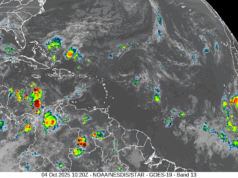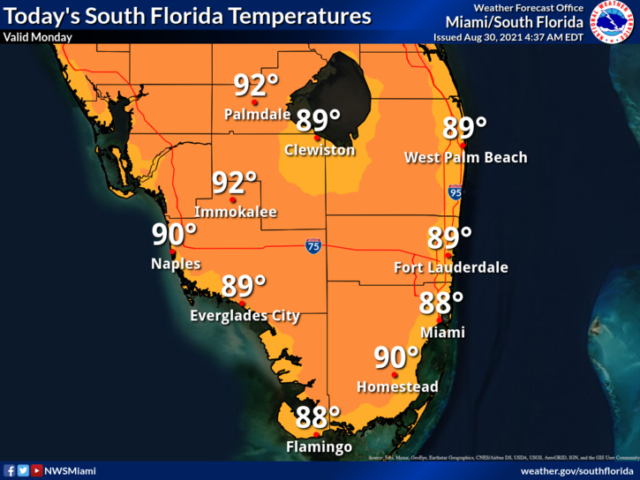
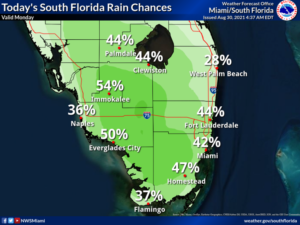 Monday features plenty of hot sun and periods of showers and storms during the mid to late afternoon. Highs on Monday will be mostly in the low 90s but some locations right at the Atlantic coast will top out in the upper 80s.
Monday features plenty of hot sun and periods of showers and storms during the mid to late afternoon. Highs on Monday will be mostly in the low 90s but some locations right at the Atlantic coast will top out in the upper 80s.
LIVE RADAR 24/7 (Click Here Then Press Play)
Tuesday will bring lots of sun with some afternoon showers and storms, especially in the east coast metro area. Tuesday’s highs will be in the low 90s in the east coast metro area and the upper 80s along the Gulf coast.
Wednesday will begin the month of September with sunny skies and a few afternoon showers with maybe a storm. Wednesday’s highs will be in the low 90s in the east coast metro area and near 90 degrees along the Gulf coast.
Thursday will feature plenty of sun, a few clouds at times, and some passing showers and storms during the mid to late afternoon. Thursday’s highs will be in the low 90s in the east coast metro area and near 90 degrees along the Gulf coast.
Friday’s forecast calls for a mix of sun, showers, and some storms at times. Highs on Friday will be near 90 degrees.
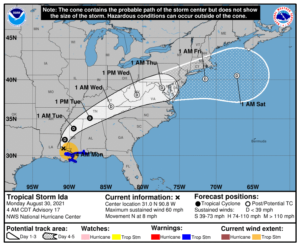 Ida is now a tropical storm, but not before bringing devastating winds and storm surge to coastal Louisiana as it made landfall on Sunday. At 5 am Monday, Tropical Storm Ida was located near 30.0 North, 90.8 West, about 95 miles south-southwest of Jackson, Mississippi. Maximum sustained winds were 60 miles per hour, and Ida was moving north at 8 miles per hour. Ida continues to bring flooding rain as it moves inland, and the Louisiana and Mississippi coasts were still feeling the effects of storm surge early on Monday.
Ida is now a tropical storm, but not before bringing devastating winds and storm surge to coastal Louisiana as it made landfall on Sunday. At 5 am Monday, Tropical Storm Ida was located near 30.0 North, 90.8 West, about 95 miles south-southwest of Jackson, Mississippi. Maximum sustained winds were 60 miles per hour, and Ida was moving north at 8 miles per hour. Ida continues to bring flooding rain as it moves inland, and the Louisiana and Mississippi coasts were still feeling the effects of storm surge early on Monday.
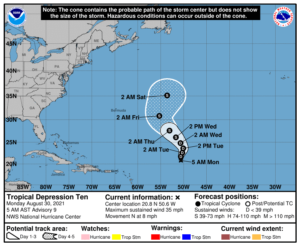 Tropical Depression # 10 is struggling against upper level winds. At 5 am, TD # 10 was located near 20.8 North, 50.6 West, about 775 miles east-northeast of the Leeward Islands. Maximum sustained winds were 35 miles per hour, and the depression was moving north at 8 miles per hour. TD # 10 still could reach tropical storm strength, but it’s expected to remain over open waters.
Tropical Depression # 10 is struggling against upper level winds. At 5 am, TD # 10 was located near 20.8 North, 50.6 West, about 775 miles east-northeast of the Leeward Islands. Maximum sustained winds were 35 miles per hour, and the depression was moving north at 8 miles per hour. TD # 10 still could reach tropical storm strength, but it’s expected to remain over open waters.
Tropical Depression # 11 became Tropical Storm Julian briefly on Sunday, but it’s now a post-tropical cyclone. At 5 am Monday, Julian was located near 38.1 North, 41.9 West, about 810 miles west of the Azores. Maximum sustained winds were 60 miles per hour, and Julian was racing northeast at 26 miles per hour into oblivion.
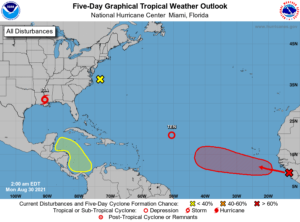 Elsewhere, a strong wave that is emerging into the eastern Atlantic has a high chance of becoming a depression during the next five days.. The low pressure area off the Delmarva peninsula has virtually no chance of developing as it drifts away from the U.S. coast. Finally, a broad area of low pressure is expected to develop in the southern Caribbean in a couple of days, and this feature has a low chance of becoming a depression during the next five days as it moves in the direction of Central America.
Elsewhere, a strong wave that is emerging into the eastern Atlantic has a high chance of becoming a depression during the next five days.. The low pressure area off the Delmarva peninsula has virtually no chance of developing as it drifts away from the U.S. coast. Finally, a broad area of low pressure is expected to develop in the southern Caribbean in a couple of days, and this feature has a low chance of becoming a depression during the next five days as it moves in the direction of Central America.
Disclaimer
The information contained in South Florida Reporter is for general information purposes only.
The South Florida Reporter assumes no responsibility for errors or omissions in the contents of the Service.
In no event shall the South Florida Reporter be liable for any special, direct, indirect, consequential, or incidental damages or any damages whatsoever, whether in an action of contract, negligence or other tort, arising out of or in connection with the use of the Service or the contents of the Service. The Company reserves the right to make additions, deletions, or modifications to the contents of the Service at any time without prior notice.
The Company does not warrant that the Service is free of viruses or other harmful components




